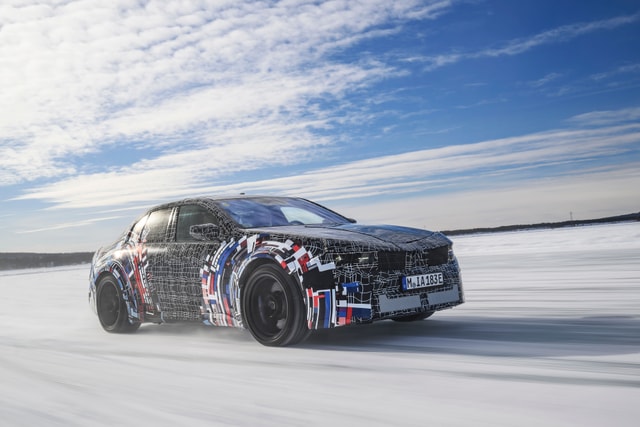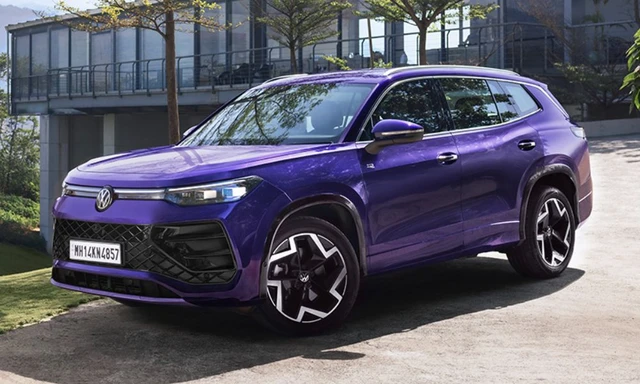Huawei Doubles Down On EVs With Suite Of Smart Components For OEMs

- Huawei has unveiled a slew of components for self driving/ electric cars
- It has also unveiled an SoC platform called the MDC 810
- The ARCFOX Alpha S will be the first vehicle based on Huawei's platform
Huawei has launched a stack of intelligent components for next-generation EVs and autonomous vehicles like a 4D imaging radar, an AR-HUD (augmented reality, heads up display), and MDC 810. Most of these products are targeting Chinese OEMs helping the market become the leader in electrification and autonomous driving. Huawei made the announcements at Auto Shanghai 2021.
Huawei has basically pivoted from smartphones to automobiles as the US trade embargoes have caused catastrophic damage to its mobile computing business and also its 5G modem business. Huawei says that it will form a team of over 5000 people working on R&D for automotive components with a total investment of $1billion. It should be remembered in the last decade no company has spent more on R&D than Huawei in the space of mobile computing and it seems like now the pivot is being made towards cars. This comes on the back of the H1 brand Huawei unveiled last October for digital cars.
The new intelligent cockpit technology that Huawei has unveiled is based on the HarmonyOS Huawei unveiled in 2019 which features applications, software and hardware ecosystem through a partnership with various OEMs, tier-1 vendors and app developers. Huawei will leverage its Kirin range of ARM processors for head units that will even feature on-demand machine learning processing through neural processing units (NPUs). Both HarmonyOS and the Kirin line of SoCs were originally designed for smartphones and IoT devices, and now they are being adapted to cars.

Huawei made a series of announcements for autonomous cars at Auto Shanghai 2021
Huawei's cockpit vision smart screen can restore colour, enable smooth touch, while the AR-HUD, is a more compact solution. A 10 L AR-HUD can transform an ordinary windshield into a 70-inch HD screen and intelligently adjust the projection area by using eye-tracking technology.
The 4D imaging radar is meant for autonomous driving. It leverages a 12T24R antenna array which provides a 24-fold improvement over the antenna configuration of conventional mmWave radars according to Huawei. Huawei claims this is the largest antenna array available for mass production right now. The 4D imaging radar delivers unique non-line-of-sight sensing strength that helps detect hidden objects while maintaining superior distance and velocity measurement capabilities of traditional mmWave radars. Huawei claims it can provide point cloud density which is on par with LiDARs enabling larger scale radar applications such as environment reconstruction, mapping and localisation. By using data from multiple radars, it can recreate a 360-degree view as well.
Using its experience making flagship-grade smartphone system-on-chip (SoC) solutions, Huawei's new MDC 810 is a computing platform for smart vehicles. It provides a computing power of 400 teraflops per second (TOPS). It enables high levels of autonomous capability and allows for driving functions like traffic jam pilot, highway pilot and auto valet parking. The ARCFOX Alpha S sedan will be the first one to feature Huawei MDC 810.

The Chinese tech giant is seemingly pivoting towards autonomous cars as its smartphone business has been rendered useless by US trade embargoes.
Building on top of this the Huawei Octopus is a full-fledged autonomous driving platform. It leverages massive data, HD Maps and advanced algorithms to build a data-driven platform for intelligent driving. Here's where all bits of the MDC810, the 4D radar, harmonyOS and the smart cockpit tech all come together using the cloud. It is a full-fledged V2X platform for OEMs.
Huawei TMS is also another solution which is a cooling solution for all these components as well as a controller for operating the thermal envelope of heat pumps between -10 degree to -18 degree Celsius. It also provides applications for OEMs to build a thermal system with optimal energy efficiency and superior experience. This solution will be critical as automobiles shift to electric power. Huawei believes its thermal management system (TMS) has achieved 100 per cent energy efficiency, 60 per cent improvement in the calibration of efficiency and an improved user experience.
Latest News
 Jaiveer Mehra | Jan 15, 2026Kia Carens Clavis Gets New Sunroof-Equipped HTE(EX) Trim; Prices Start From Rs 12.55 LakhNew lower mid-spec trim is positioned between the HTE(O) and HTK variants and gets some additional features.1 min read
Jaiveer Mehra | Jan 15, 2026Kia Carens Clavis Gets New Sunroof-Equipped HTE(EX) Trim; Prices Start From Rs 12.55 LakhNew lower mid-spec trim is positioned between the HTE(O) and HTK variants and gets some additional features.1 min read Seshan Vijayraghvan | Jan 15, 2026All Electric BMW M3 Details Out; Will Offer Simulated Gear Shifts, Synthetic SoundsThe first EV from the high-performance division of BMW will get individual electric motors of all 4 wheels1 min read
Seshan Vijayraghvan | Jan 15, 2026All Electric BMW M3 Details Out; Will Offer Simulated Gear Shifts, Synthetic SoundsThe first EV from the high-performance division of BMW will get individual electric motors of all 4 wheels1 min read Jaiveer Mehra | Jan 15, 2026Volvo EX60 SUV Global Debut On Jan 21; Will Offer 810 km RangeNew GLC EV rival will be the first Volvo to use the next-gen SPA3 platform and support 400 kW fast charging.1 min read
Jaiveer Mehra | Jan 15, 2026Volvo EX60 SUV Global Debut On Jan 21; Will Offer 810 km RangeNew GLC EV rival will be the first Volvo to use the next-gen SPA3 platform and support 400 kW fast charging.1 min read Jaiveer Mehra | Jan 15, 2026India-Spec Volkswagen Tayron RevealedThree-row SUV will be offered in the R-Line trim with features like 19-inch wheels, a 15-inch touchscreen, front seats with ventilation & massage function and more.1 min read
Jaiveer Mehra | Jan 15, 2026India-Spec Volkswagen Tayron RevealedThree-row SUV will be offered in the R-Line trim with features like 19-inch wheels, a 15-inch touchscreen, front seats with ventilation & massage function and more.1 min read car&bike Team | Jan 15, 2026Mercedes-Benz EQS SUV Gets A Celebration Edition For 2026, Prices start at Rs. 1.34 CroreThe new celebration edition will be available with both the EQS 450 and the EQS 580 versions of the SUV.1 min read
car&bike Team | Jan 15, 2026Mercedes-Benz EQS SUV Gets A Celebration Edition For 2026, Prices start at Rs. 1.34 CroreThe new celebration edition will be available with both the EQS 450 and the EQS 580 versions of the SUV.1 min read Jaiveer Mehra | Jan 15, 2026Auto Sales: Mercedes-Benz Sales Decline 3 Per Cent; 19,007 Units Sold In CY2025The German carmaker reported year-on-year growth in sales for its Top-End Vehicles (TEVs), EV range, and AMG models, although sales in entry-level segments were down 20 per cent.3 mins read
Jaiveer Mehra | Jan 15, 2026Auto Sales: Mercedes-Benz Sales Decline 3 Per Cent; 19,007 Units Sold In CY2025The German carmaker reported year-on-year growth in sales for its Top-End Vehicles (TEVs), EV range, and AMG models, although sales in entry-level segments were down 20 per cent.3 mins read
 Bilal Firfiray | Jan 9, 2026Toyota Urban Cruiser Hyryder: 10,000 km Long-Term ReviewAfter spending over three months and 10,000 km with the Toyota Urban Cruiser Hyryder Hybrid, we were impressed by its real-world mileage, seamless hybrid, practical comfort, and Toyota reliability. Is it the best C-SUV then?5 mins read
Bilal Firfiray | Jan 9, 2026Toyota Urban Cruiser Hyryder: 10,000 km Long-Term ReviewAfter spending over three months and 10,000 km with the Toyota Urban Cruiser Hyryder Hybrid, we were impressed by its real-world mileage, seamless hybrid, practical comfort, and Toyota reliability. Is it the best C-SUV then?5 mins read Seshan Vijayraghvan | Jan 8, 20262026 Mahindra XUV 7XO Review: Big On Tech, Bigger On ComfortThe new Mahindra XUV 7XO is flashier, feature packed, and comes with more advanced tech. But are the changes just incremental or actually substantial?1 min read
Seshan Vijayraghvan | Jan 8, 20262026 Mahindra XUV 7XO Review: Big On Tech, Bigger On ComfortThe new Mahindra XUV 7XO is flashier, feature packed, and comes with more advanced tech. But are the changes just incremental or actually substantial?1 min read Preetam Bora | Jan 10, 2026Simple One Gen 2 First Ride Review: 265 km Claimed Range!The Gen 2 model of Simple Energy’s first electric scooter gets a fair few updates, including new features, tech, more range and lighter weight. We spent a couple of hours with the Simple One Gen 2 to find out if it manages to impress.6 mins read
Preetam Bora | Jan 10, 2026Simple One Gen 2 First Ride Review: 265 km Claimed Range!The Gen 2 model of Simple Energy’s first electric scooter gets a fair few updates, including new features, tech, more range and lighter weight. We spent a couple of hours with the Simple One Gen 2 to find out if it manages to impress.6 mins read Amaan Ahmed | Jan 3, 2026VLF Mobster 135 300 KM Review: Fun But FlawedA 125 cc scooter with Italian design and Chinese genes is a rare combination, and while some may be tempted to dismiss it because of its origins, the VLF Mobster shows 125s can also be exciting – but not without compromises.11 mins read
Amaan Ahmed | Jan 3, 2026VLF Mobster 135 300 KM Review: Fun But FlawedA 125 cc scooter with Italian design and Chinese genes is a rare combination, and while some may be tempted to dismiss it because of its origins, the VLF Mobster shows 125s can also be exciting – but not without compromises.11 mins read Preetam Bora | Dec 30, 2025TVS Orbiter Review: Real-World Performance and Range TestedThe TVS Orbiter is a promising electric scooter promising decent range, practicality and pricing. But is there any reason to avoid it? We spent a few days getting to know it better.9 mins read
Preetam Bora | Dec 30, 2025TVS Orbiter Review: Real-World Performance and Range TestedThe TVS Orbiter is a promising electric scooter promising decent range, practicality and pricing. But is there any reason to avoid it? We spent a few days getting to know it better.9 mins read




















































































































